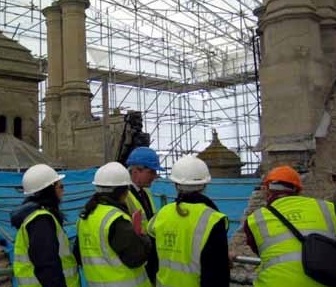Historic Environment Scotland has awarded £190,000 to war memorial repair projects and £1.7 million under the Building Repair Grants Scheme.
Historic Environment Scotland writes:
Scotland’s newly formed lead public body for heritage, Historic Environment Scotland, has announced grants of £1.7 million worth of funding to repair historically important buildings across the country.
The funds are being divided between five different projects as part of the body’s Building Repair Grants Scheme.
The is part of a wider commitment to invest around £14 million annually in the historic environment, through initiatives such as the successful Conservation Area Regeneration Schemes, Building Repair Grants, and archaeological excavations and surveys. In the preceding five-years of grants of £62 million have levered in a further £230 million of investment in Scotland’s historic environment sector.
Among the recipients announced today is the Edwardian Govan Hill Baths in Glasgow, which is to be refurbished in a phased scheme to facilitate full community usage for three pools, a steamie and Turkish Baths suite. That project received an award of £500,000 to pay for repairs to halt water ingress and refurbish the interior of the building.
A new use for the Old Achintore School in Fort William has also been found, following years of discussions around the building’s potential demolition. Following a grant award of £269,750 it will now be refurbished to act as a Civic Centre for the town, and offices for Highland Council staff.
The former Dumbarton Academy, which on completion will be utilised as the new West Dunbarton Council HQ, housing over 500 council staff, is expected to bring much needed additional trade to town-centre businesses. The former Davidson Cottage Hospital in Girvan will receive funding for conversion to an Enterprise Centre for business space, childcare facilities, and office accommodation. Finally, the former British Linen Bank is to get a major restoration, as part of a wider scheme to regenerate the surrounding area by the Southside Housing Association, and to provide additional social housing units.
This follows grants awarded in August 2015 through the same scheme, with grants at that time being awarded to high profile projects such as the renovation of Moat Brae House in Dumfries, where JM Barrie wrote the children’s classic Peter Pan; repairs to the Jewish Enclosure of the Glasgow Necropolis; the conversion of the Calton Hill Observatory in Edinburgh into a public arts space; and the restoration of one of Britain’s three surviving train turntables, to name just a few.
Historic Environment Scotland is the new lead public body established to investigate, care for and promote Scotland’s historic environment. The organisation is a Non Departmental Public Body and a registered Scottish Charity which incorporates and will build on the strengths and expertise of Historic Scotland and the Royal Commission on the Ancient and Historical Monuments of Scotland (RCAHMS) who have been managing and recording the historic environment for over a century.
View the press release on building repair grants, including a full list of recipients at http://www.historic-scotland.gov.uk/index/news/news_article.htm?articleid=47454
View the press release on war memorials at http://www.historic-scotland.gov.uk/index/news/news_article.htm?articleid=47476




